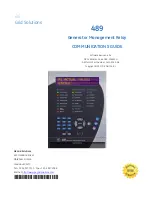
GEK-49861
operation, has been set in co-ordination with the P2 potentiometer at
the factory and sealed.
Potentiometer Pl must not be readjusted.
Potentiometer P2 is set for a 4. 16 millisecond
(50 hertz
5. 0
milliseconds)
pickup
time.
The
4. 16
millisecond
(50
hertz
character is tic; times longer that 4. 16 milliseconds (50 hertz - 5. 0
milliseconds) tend to nar row the characteristic and times shorter
than 4. 16 milliseconds (50 hertz - 5. 0 milliseconds) tend to widen
the character is tic.
Turning the P2 potentiometer clockwise will
increase the pickup time delay.
Potentiometer P3 is set for a five
millisecond
(50
hertz
6. 0
milliseconds)
dropout
time
delay.
Turning the P3 potentiometer clockwise will increase the dropout time
delay.
The test circuit of Figure 31 may be used to check the steady
state pickup time setting.
(The same r esults will be obtained if the
test circuit of Figure 24 is used in place of the test circuit of
Figur e 31. ) A dual trace oscilloscope should be used with channel "A"
connected to test point "AIN" on the IT card and channel "B" on test
point "OUT" on the IT card.
Connect unused inputs "AIN", "BIN", or
"CIN" on IT card to "OV" test point on PS card.
In order to observe
the pickup time delay, the dropout time delay must be r educed by
turning P3 counterclockwise so that the output resets each half
cycle.
Reduce "VT" until the relay picks up and the output (channel
B) should go positive 4. 16 milliseconds (50 hertz
-
5. 0 milliseconds)
after the input (channel A) goes positive.
After the pickup time is
checked, P3 should then be turned clockwise until the output (channel
B) produces a continuous positive signal.
P3 should then be turned
clockwise for one additional turn.
As a final check on the accuracy of the 4. 16 milliseconds, (50
hertz - 5. 0 milliseconds) the mho characteristic may be rechecked and
compared with the desir ed characteristic.
To
check
the
transient
pickup
time
setting,
the
following
procedure should be used:
(a) Remove the CL card
(b) Connect the test circuit of Figure 26
(c) With the oscilloscope trigger on positive slope, open the
normally closed contact.
The
Channel Two trace should step
positive 5. 5 milliseconds (50 hertz
-
6. 6 milliseconds) (±0. 1
millisecond) after the Channel One trace steps positive.
6 .
Overcurrent
Tests
There are potentiometers on the SP card for adjustment of the
sensitivity of the overcurr ent supervision signal for each phase pair
as shown in table XVI.
The test circuit for setting sensitivity of the overcurr ent
super v1s1on signal is shown in Figure 24
(or Figure 31) .
The
recommended procedure for setting sensitivity is as follows:
a)
Make connections for phase pair AB and adjust current IT to
the desir ed value of current super vision (between maximum
load curr ent and minimum fault current) .
Set the phase
shifter for a phase angle meter reading at 85° .
23
www
. ElectricalPartManuals
. com
















































